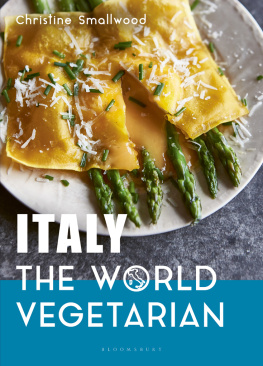Christine Smallwood - Italy - The World Vegetarian
Here you can read online Christine Smallwood - Italy - The World Vegetarian full text of the book (entire story) in english for free. Download pdf and epub, get meaning, cover and reviews about this ebook. year: 2020, genre: Home and family. Description of the work, (preface) as well as reviews are available. Best literature library LitArk.com created for fans of good reading and offers a wide selection of genres:
Romance novel
Science fiction
Adventure
Detective
Science
History
Home and family
Prose
Art
Politics
Computer
Non-fiction
Religion
Business
Children
Humor
Choose a favorite category and find really read worthwhile books. Enjoy immersion in the world of imagination, feel the emotions of the characters or learn something new for yourself, make an fascinating discovery.
- Book:Italy - The World Vegetarian
- Author:
- Genre:
- Year:2020
- Rating:3 / 5
- Favourites:Add to favourites
- Your mark:
- 60
- 1
- 2
- 3
- 4
- 5
Italy - The World Vegetarian: summary, description and annotation
We offer to read an annotation, description, summary or preface (depends on what the author of the book "Italy - The World Vegetarian" wrote himself). If you haven't found the necessary information about the book — write in the comments, we will try to find it.
Italy - The World Vegetarian — read online for free the complete book (whole text) full work
Below is the text of the book, divided by pages. System saving the place of the last page read, allows you to conveniently read the book "Italy - The World Vegetarian" online for free, without having to search again every time where you left off. Put a bookmark, and you can go to the page where you finished reading at any time.
Font size:
Interval:
Bookmark:



To my Father who introduced me to Italy, and Dan, who took me back there.
INTRODUCTION

Italians enthuse about vegetables and appreciate them daily. At busy fresh produce markets, the respect for locally grown veg is plain to see. Customers admire newly arrived artichokes and chat at length about the exquisite radicchio before returning home with overflowing baskets.
It was at the large and buzzing market in Martina Franca, in central Puglia, where I first noticed something revealing about the price signs. They did not say fennel or aubergine alongside the cost (as its obvious what the vegetable is), but the signs did specify Fasano or SantAgostino to show where the veg were grown. Some indicated Sicilia or other regions, but most places were nearby and the vegetables were at their seasonal best.
Excitement over short-seasoned veg, such as asparagus, is an inspiring way to approach cooking whether you are a full-time vegetarian or endeavouring to eat less meat and fish. As with all ingredients in Italy, vegetables are important and receive serious attention because they are not the backing chorus but often the stars of the show. They indisputably shine in the recipes in this book. As a restaurant owner once said to me, Why are our mothers great cooks? Because they know how to shop well; they know how to recognise good, fresh produce, because thats the basis of everything.
And having shopped well, even if you are in the fortunate position of being able to buy fresh veg daily, you need to know how to store it well; dont automatically put everything in the fridge. For example, keep your tomatoes in the fruit bowl and your garlic at room temperature. If you can, buy in small quantities, and use quickly, even if for preserving.
The preservation of vegetables in vinegar or oil is popular in Italy and olive oil especially is an important ingredient in the countrys gastronomy. Many of the recipes in this book include it, not only to facilitate cooking or as a final enrichment, but as a major component. Treat yourself to a top-quality oil knowing that it will be a fundamental characteristic of your Italian dishes.
At the time of writing, vegetarian cheese is a challenge in Italy. I have lost count of the number of conversations Ive had, even with chefs who offer extensive vegetarian options, about Parmesan, for example, not being suitable. But there is a slowly increasing number of cheese makers in Italy who are using non-animal rennet, so stay tuned.
A reliable, standby dish for many vegetarians is chopped, sauted veg served with pasta. Italian culinary purists may roll their eyes at some such improvisations. No matter. This book contains different approaches for suitable pasta dishes as well as small dishes that tend to come from the antipasto course at the start of the meal. Although in many parts of the country this course may often be one dish, in some places the antipasti are almost a meal in themselves. (My record is being served 24 antipasti plates at a trattoria in Puglia, and that was before the two dishes of pasta arrived.) When you eat out in Italy, antipasti often provide some interesting choices for the vegetarian. Combining a few of these small dishes to make a substantial meal works well when cooking at home.
Typical and much-loved dishes are a big part of Italys culture, but not every Italian is inflexibly tradition-bound in their home cooking. Some of the recipes that follow are contemporary, and some are classic dishes although they may well be variations on versions that you know. Using wonton wrappers for ravioli is far from traditional, but if they work for some Italians, then who are we to question? There are dishes here from the length of the country as well as all the seasons: from the rib-sticking, hearty dish of pizzoccheri found in northern Lombardys Valtellina, via a pie of mixed greens from Emilia-Romagna, to Palermos caponata on the island of Sicily.
Yet I have omitted one obvious and internationally popular dish that lends itself easily to a vegetarian version: pizza. Please dont think that Ive forgotten about it (Im a big fan of pizza), but this book is taking the Italian view: go to a pizzeria, where the pizzaiolo will have the right equipment and skills, for a relaxed evening out with friends, rather than making one in your own kitchen. (Ive enjoyed many a pizza in Italy, but never at someones home.)
Unsurprisingly, it has been when spending time and eating in peoples homes that Ive learnt a lot about how they cook. How simple and straightforward most peoples kitchen equipment is: knives, chopping boards, bowls, pans, a handheld blender, perhaps machines for making passata and rolling pasta. A puntarelle cutter is about as gadgety as it gets.
Its been said that we often forget the relationships involved in our food, those connections between the producer, picker, distributor and seller. Eating is also, if were lucky, a part of the relationship we have with people, and in turn the exchange of recipes often happens because of the associations we have built and nurtured. Many of the recipes that follow are based on those cooked by Italians who, over many years, have become very good friends. Others are from people Ive just crossed paths, or spoons, with, for the briefest of moments. Theyve all been generous with their time, and advice, and they have all been enthusiastic about eating vegetables. But then this has been the case for many centuries, as stated by Jane Grigson in her foreword to the translation of Giacomo Castelvetros The Fruit, Herbs & Vegetables of Italy in which she mentions An Italians message to England in 1614: Eat more fruit and vegetables.
And while preparing them, there is another aspect to Italian home cooking that is often lost when following a recipe and respecting tradition. Namely the level of engagement needed when cooking. Dont just leave your pan on the heat, relying on a timer and trusting that when it rings, all will be as you wish. Use extra water if your hob is fierce or less oil if your pan is small. Test and taste regularly. Add more garlic, adjust the amount of chilli or reduce the quantity of herbs if you so wish. In other words, make these dishes your own and above all, have fun with these recipes.
It has been said on many occasions that Italy is not a country but a way of life. I hope this book will help you to enjoy vegetarian food the Italian way.
SMALL PLATES

FOCACCIA BARESE
BARI-STYLE FOCACCIA
When we think of focaccia, it is usually the Genovese recipe with its olive-oil-filled dimples. This is the Bari version, from Puglia at the other end of Italy, and it includes mashed potato. My friend Anna Cavaliere makes the best one I know, using a mixture of type 0 and type 2 flours (I use flours that are more readily available outside Italy). She also uses Termitte di Bitetto olives with the stones left in along with a warning to prevent eaters needing a surprise visit to the dentist. Her husband, Vittorio, stresses the difference that excellent extra-virgin olive oil makes, and he is right.
Font size:
Interval:
Bookmark:
Similar books «Italy - The World Vegetarian»
Look at similar books to Italy - The World Vegetarian. We have selected literature similar in name and meaning in the hope of providing readers with more options to find new, interesting, not yet read works.
Discussion, reviews of the book Italy - The World Vegetarian and just readers' own opinions. Leave your comments, write what you think about the work, its meaning or the main characters. Specify what exactly you liked and what you didn't like, and why you think so.










